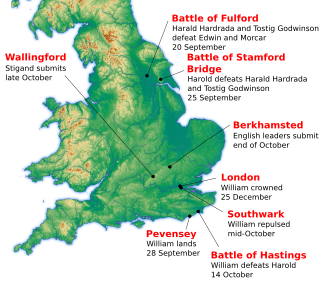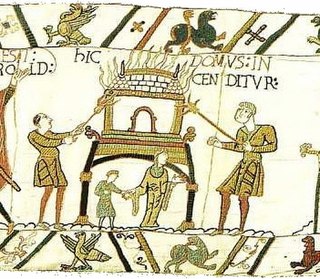The 1060s was a decade of the Julian Calendar which began on January 1, 1060, and ended on December 31, 1069.

Harold Godwinson, also called Harold II, was the last crowned Anglo-Saxon English king. Harold reigned from 6 January 1066 until his death at the Battle of Hastings, fighting the Norman invaders led by William the Conqueror during the Norman Conquest of England. His death marked the end of Anglo-Saxon rule over England.

Year 1064 (MLXIV) was a leap year starting on Thursday of the Julian calendar.

The Battle of Hastings was fought on 14 October 1066 between the Norman-French army of William, the Duke of Normandy, and an English army under the Anglo-Saxon King Harold Godwinson, beginning the Norman Conquest of England. It took place approximately 7 mi (11 km) northwest of Hastings, close to the present-day town of Battle, East Sussex, and was a decisive Norman victory.

Harald Sigurdsson, also known as Harald III of Norway and given the epithet Hardrada in the sagas, was King of Norway from 1046 to 1066. Additionally, he unsuccessfully claimed both the Danish throne until 1064 and the English throne in 1066. Before becoming king, Harald had spent around fifteen years in exile as a mercenary and military commander in Kievan Rus' and as a chief of the Varangian Guard in the Byzantine Empire. In his chronicle, Adam of Bremen called him the "Thunderbolt of the North".

The Battle of Stamford Bridge took place at the village of Stamford Bridge, East Riding of Yorkshire, in England, on 25 September 1066, between an English army under King Harold Godwinson and an invading Norwegian force led by King Harald Hardrada and the English king's brother Tostig Godwinson. After a bloody battle, both Hardrada and Tostig, along with most of the Norwegians, were killed. Although Harold Godwinson repelled the Norwegian invaders, his army was defeated by the Normans at Hastings less than three weeks later. The battle has traditionally been presented as symbolising the end of the Viking Age, although major Scandinavian campaigns in Britain and Ireland occurred in the following decades, such as those of King Sweyn Estrithson of Denmark in 1069–1070 and King Magnus Barefoot of Norway in 1098 and 1102–1103.

The Norman Conquest was the 11th-century invasion and occupation of England by an army made up of thousands of Norman, French, Flemish, and Breton troops, all led by the Duke of Normandy, later styled William the Conqueror.
Tostig Godwinson was an Anglo-Saxon Earl of Northumbria and brother of King Harold Godwinson. After being exiled by his brother, Tostig supported the Norwegian king Harald Hardrada's invasion of England, and was killed alongside Hardrada at the Battle of Stamford Bridge in 1066.

The Battle of Fulford was fought on the outskirts of the village of Fulford just south of York in England, on 20 September 1066, when King Harald III of Norway, also known as Harald Hardrada, a claimant to the English throne and Tostig Godwinson, his English ally, fought and defeated the Northern Earls Edwin and Morcar.
Gytha Thorkelsdóttir, also called Githa, was a Danish noblewoman. She was the wife of Godwin, Earl of Wessex, and the mother of King Harold Godwinson and Edith of Wessex, the latter of whom was the queen consort of King Edward the Confessor.

Edith of Wessex was Queen of England through her marriage to Edward the Confessor from 1045 until Edward's death in 1066. Unlike most English queens in the 10th and 11th centuries, she was crowned. The principal source on her life is a work she herself commissioned, the Vita Ædwardi Regis or the Life of King Edward who rests at Westminster, which is inevitably biased.
Morcar was the son of Ælfgār and brother of Ēadwine. He was the earl of Northumbria from 1065 to 1066, when William the Conqueror replaced him with Copsi.
Edwin was the elder brother of Morcar, Earl of Northumbria, son of Ælfgār, Earl of Mercia and grandson of Leofric, Earl of Mercia. He succeeded to his father's title and responsibilities on Ælfgār's death in 1062. He appears as Earl Edwin in the Domesday Book.
Events from the 1060s in England.
William I of England has been depicted in a number of modern works.

The House of Godwin is an Anglo-Saxon family who were one of the leading noble families in England during the last fifty years before the Norman Conquest. Its most famous member was Harold Godwinson, King of England for nine months in 1066.

Haralds saga Sigurðarsonar is an Old Icelandic king's saga focusing on the career of King Haraldr Sigurðarson of Norway.

Judith of Flanders was, by her successive marriages to Tostig Godwinson and Welf I, Countess of Northumbria and Duchess of Bavaria.
The Treaty of Abernethy was signed at the Scottish village of Abernethy in 1072 by King Malcolm III of Scotland and by William of Normandy.

The Burning of Southwark was a battle fought in Southwark during the Norman Conquest of England in October 1066.











